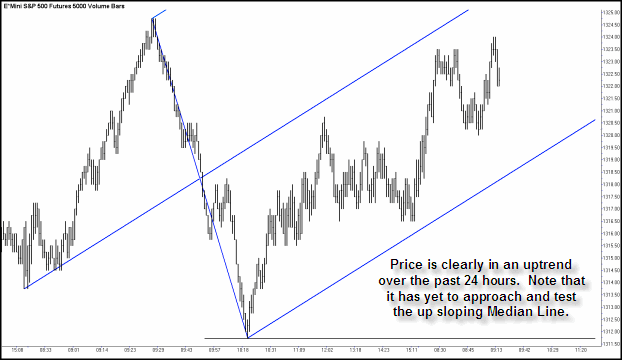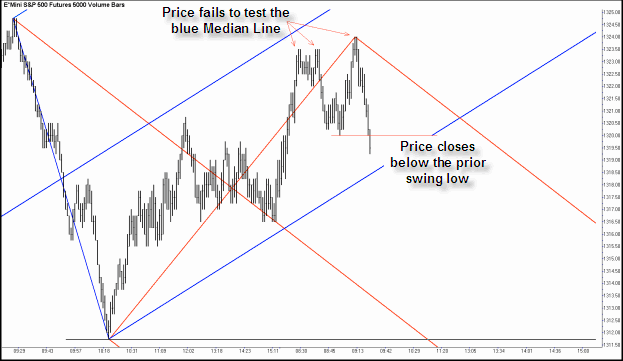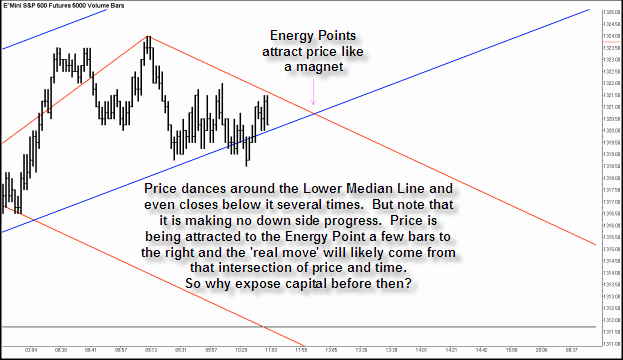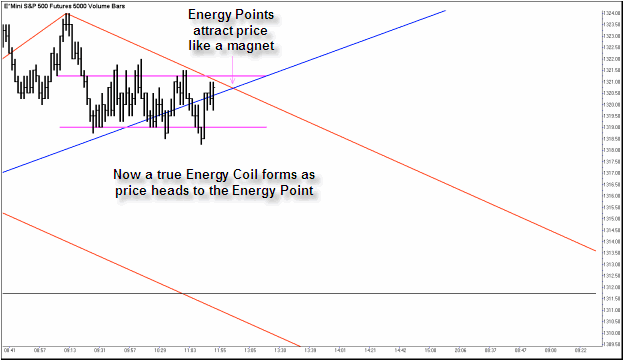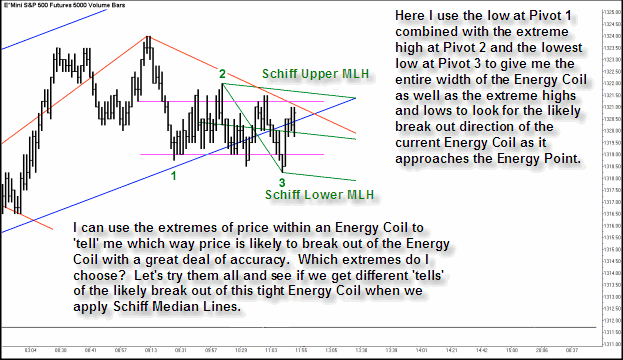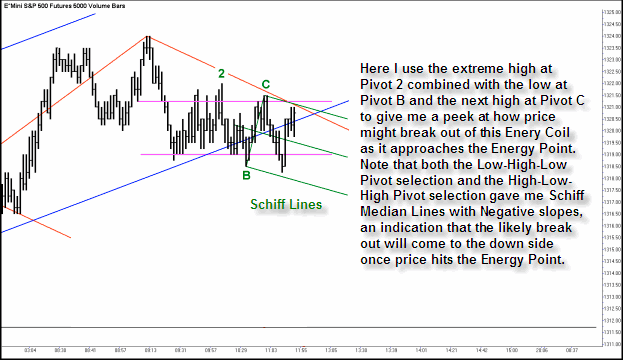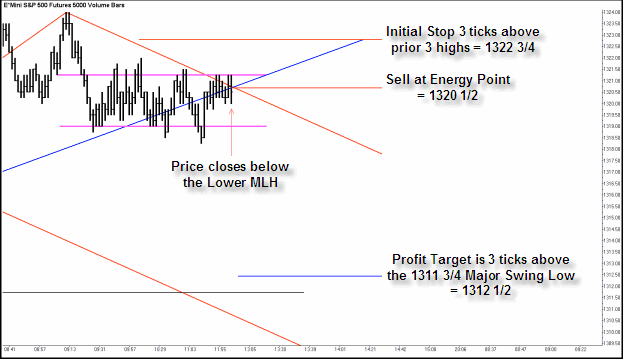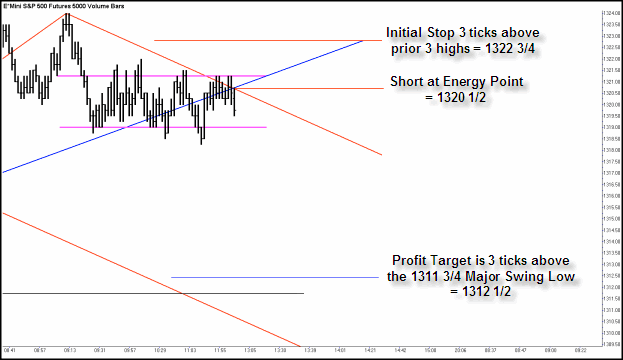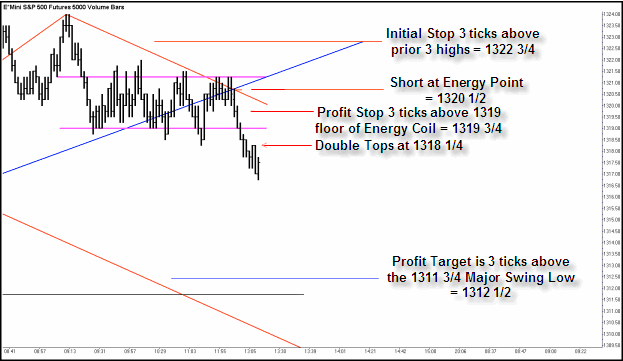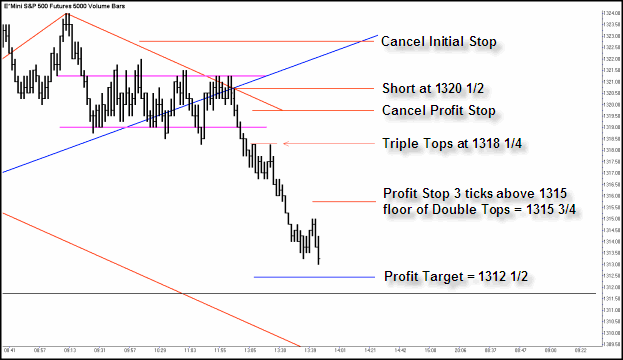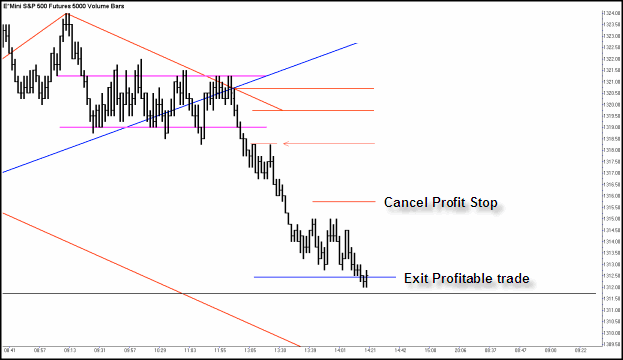to Find Better Trade location! by Timothy Morge What do major league baseball pitches, houses for sale and trade entries all have in common? Location, location, location! Major league baseball hitters can hit 100 mile per hour fastballs fairly well if they are thrown over the heart of the plate. But if the pitcher can paint the corners of the plate with 100 mile an hour fastballs, most of the batters he faces will be sitting down grumbling after striking out. Similarly, if you look at two houses that are on the same size lot and are fairly similarly built, the one with the best location will sell faster and for more money. What’s that got to do with trading? If you can clear away some of the noise of the markets and add a few simple tools, you’ll find that finding a quality trade entry location is a snap and you’ll find better trade entry location will greatly improve your trading results! The E-Mini S&P futures are notoriously noisy during the U.S. trading day and if you view a 24 hour Globex chart, they have periods of inactivity, which means that many indicators like moving averages and drawing tools like Median Lines are skewed by the passage of time during these dead periods. One solution that addresses both concerns is to use bar charts that are built with price on one axis and volume traded on the other axis: In this case, I have chosen to plot a new bar each time 5000 contracts trade electronically. Depending on the level of activity of the current conditions, you can vary the size of the volume bars—when price is in an extremely active period, I chart 10,000 volume price bars and when price has settled down into one of those periods where six to eight point ranges are the norm, I generally move back down to the 5000 volume bar size. But either of these choices will do a good job of taking out the noise and eliminating the skewing problem associated with the dead periods in the 24 hour charts of these markets. Now let’s look at an actual trade example, in a step by step fashion, so you can see how I use these non-time based bar charts and incorporate a few interesting twists to help me locate quality trade entries.
Price has rebounded nicely from the 1311 ¾ lows made early in the prior day’s session and is clearly in a strong up trend. Although price is trading well within the blue up sloping Median Line drawn off of the major pivots, note that it has not tested the Median Line or its Lower Median Line Parallel. In other words, the slope of this Median Line has done a good job telling us where price is headed, but these lines are untested! Be careful taking a trade off of them until they are tested.
Now note that price trades higher, making a new high, but then trades below and closes the prior swing low. And since price still has not tested the Median Line, this is a sign of weakness. We’ve now had three tests in a very confined area that tried to go higher and made little or no progress and now price is closing below prior swing lows! Note that I added a red down sloping Median Line and its Parallels after price closed below the prior swing low. I don’t have a trade entry idea yet, but I do now have two signs of weakness: Price is closing below prior swing lows and price failed to make it to the up sloping Median Line [This is referred to as Hagopian’s rule] and the combination has me concerned that we may be setting up for quite a large sell off unless price quickly makes some up side progress.
Price now trades lower and tests the blue up sloping Lower Median Line and then begins to form an Energy Coil or trading range. Note that to the right of the current price action, there is an area where two lines of opposing force, one up sloping and one down sloping, meet. This is called an Energy Point and especially when you encounter Energy Points within the vicinity of Energy Coils, you can assume that the Energy Point will act as a magnet to price—It will attract price and drag it towards itself! Looking at the chart above, you can see that if that IS the case, we really don’t want to enter a trade until right at or very near the Energy Point, because there is no point in having our capital exposed if price is going to range trade! It’s better to keep our capital safe and wait until we have a solid idea where price is heading and when price is going to break out of the tight range.
You can see that price is firmly entrenched in the Energy Coil and seems to be headed right for a test of the Energy Point or where the lines of opposing force intersect. In my research, I see time and again that these areas are where price will resolve its ranging activity, so I am generally willing to wait until price gets to within one or two bars of the upcoming Energy Point before committing capital—because there is no need to expose my capital to any risk if price is likely to remain in a range unless an outside price shock [which would be random in nature] moves price out of the Energy Coil before price and time come together at the intersection of the opposing lines of force. Now let me show you a neat little way I’ve developed to help me tell which way price will resolve or move out of an Energy Coil.
Note that in drawing the Energy Coil or trading range boundaries, I’ve connected multiple tops and multiple bottoms and I’ve left a few extreme prices on both sides outside the drawn boundaries of the Energy Coil. These extremes are the false breakouts that plague so many traders trying to "grab a ride" on the market’s momentum by buying breakouts from trading ranges or triangles or diamonds. But they can also be very useful signposts if you have the tools to read them. One tool, the Schiff Median Line, can be used in conjunction with these extremes to give you an idea of the likely direction of the breakout. By using the alternating extreme false breakouts as pivots and drawing in a Schiff Median Line, the slope of the resulting Schiff Median Line gives us a good indication of the likely breakout from the current Energy Coil. In the prior chart, I used the widest set of extremes, starting with a low pivot.
This gave me a down sloping Schiff Median Line. In this example, I began with the highest extreme pivot and again, it gave me a down sloping Schiff Median Line. Even though I began one Schiff Median Line with a low pivot and another with the extreme high pivot, both resulting Schiff Median Lines are telling me the likely breakout will come to the down side. Neither tell me when or at what price, but they give me a strong indication that the break out will come to the down side. Now I need price location! And that will likely come at or near the Energy Point where the lines of opposing force meet.
Price has now crept sideways towards the Energy Point and is either right at it or one bar from it. And note that in the past 8 to 10 bars, price hasn’t moved much. We’ve had several closes above the blue Lower Median Line Parallel and several below it—but it’s still mired in congestion. What makes me think we’re likely to break out now? The proximity of price with the Energy Point! Now that I’ve sat through the passage of a great deal of time as price re-stored its expended energy, I think the Schiff Median Line tool has given me a strong indication that price will break to the down side, so I am now willing to try to enter a short E-Mini S&P position. I want to sell S&P futures at 1320 ½, right at the Energy Point, and if my limit order is filled, my initial stop loss order will be three ticks above the prior three swing highs, at 1322 ¾. And my profit target will be a test of the prior 1311 ¾ Major Swing Low—I’ll put my profit order 3 ticks above this prior low at 1312 ½.
Price comes up and tests the Energy Point, exceeding it by one tick and getting me short in the process at 1320 ½. I always enter my limit entry orders and stop loss orders at the same time and then once my limit order is filled, I first double check that my initial stop loss order is still being worked—If it is, I then place my profit order. So in this case, I am short E-Mini S&Ps at 1320 ½ with an initial stop loss order at 1322 ¾ and a profit target of 1312 ½. My initial risk is 2 ¼ points and my profit target is 8 points away, so my risk reward ratio is a very nearly 4:1. Price trades lower in an orderly fashion, eventually breaking and closing below the lower boundaries of the Energy Coil.
And after price leaves double tops at 1318 ¼ and then makes a new low for the move [which means these double tops should draw in sellers should price climb back to re-test them], I move my initial stop loss to a stop profit, 3 ticks above the 1319 lower boundary of the Energy Coil, to 1319 ¾. If price climbs back into this Energy Coil, I no longer want to be involved—I’ll just take whatever profits are still on the table and look for a new trade idea.
Price does come back up to test the double tops at 1318 ¼ several bars later and turns on a dime, telling me that there indeed were sell orders waiting above those double tops [which are now triple tops]. Then price again heads down in an orderly fashion, getting within a point or so of hitting my profit target at 1312 ½ before congesting again and then turning higher. But the rally is short lived and price again leaves double tops. Because we have come down nicely and gotten very close to my profit target, I don’t want to give away any of my hard-earned profits, so when price makes a new low for the day, I snug my profit stop to 3 ticks above the just made 1315 double tops, to 1315 ¾. Price again makes a new low but then consolidates again, testing the 1315 double tops several times—and each time, there were solid sellers in this area!
Once the buying dried up, price headed lower and soon hit my profit order at 1312 ½. Once I see my price print, I make certain that I am filled on my profit order and then I cancel my stop orders and double check two things: That I am working no further orders and that I bought and sold an equal amount of contracts. It’s too difficult to make money trading to give it up to simple execution errors because of sloppiness. This was a nice clean trade in the E-Mini S&P futures that netted me 8 points per contract [roughly $400 per contract before commissions]. The keys to this trade were 1) Using volume bars to filter out the skewing of price and time during the dead periods in the 24-hour markets, 2) Identifying early on that price was forming an Energy Coil and then waiting patiently as price was pulled to the Energy Point, 3) Using the Schiff Median Line variant to help get a "tell" from the market action about the likely resolution of the Energy Coil as price approached the Energy Point, 4) Identifying swing highs to hide Initial and Profit Stops behind, allowing me to hide my stop loss buy orders above the sell orders of other market participants, and 5) Finding a solid Logical Profit Objective to lock in prices. The Ensign Windows charting platform is filled with great trading and charting tools and allows traders to explore various types of charting techniques—including non-time based bars that include tick charts, volume bars and range bars. I hope you find this example interesting and informative. I wish you all good trading! |
